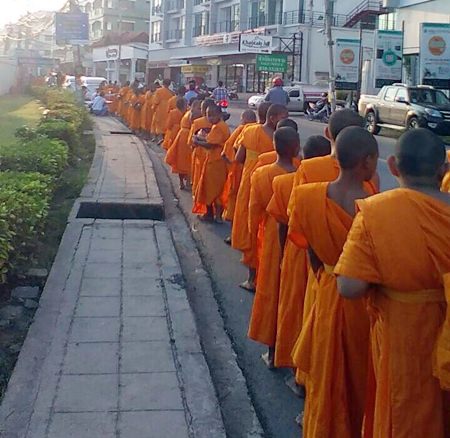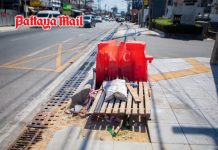Buddhists from Sattahip to Pattaya celebrated the end of three months of lent and welcomed monks back into the community with alms offerings from morning to night.
Auk Phansa, the end of Buddhist Lent, and the Tak Bat Devo ceremony the following day are the two-day observance of the end of the “rains retreat,” where, in olden times, monks remained within temple walls to avoid trampling rice crops and studied dharma by candlelight. Things have progressed since the tradition began, but its roots remain pure in spirit. Buddhists welcome the monks back to society with presentations of meats and desserts.
 Young monks line the street to accept alms marking Auk Phansa, the end of Buddhist Lent.
Young monks line the street to accept alms marking Auk Phansa, the end of Buddhist Lent.
Pattaya residents eagerly prepared food, sweets, fruits and incense to present to monks at 41 temples around the city while believers in Sattahip participated in re-enactments of Lord Buddha’s return to earth from heaven.
At Boonsamphan Kanjanaram Temple on Soi Kao Talo Abbot Wisutpiyakorn welcomed local residents who brought food offerings, incense, candles, flowers and others items to offer up in exchange for blessings from the monks.
Moreover, merit was made for late family members and friends, devotees took in dharma lessons, meditated, and cleaned the temple grounds.
About 130 monks from the Nemthawan Dharma Center went out to collect alms on Soi Khao Talo early on Auk Phansa. Residents lined the road and prepared various goods for them. Then, at 6 p.m., a “dhammachak khapwathansoot” ceremony was held at the Khao Wai center.
Sattahip
In Sattahip, Khao Baisri Temple held its annual re-enactment of Buddha’s return, carried out by seven monks and 21 novices, who walked down the mountain to receive alms.
Manus Suwanrin, senior assistant district chief, led local residents in bringing thousands of pieces of khao tom mud, a sweet treat of sticky rice, banana, black bean, and sugar wrapped in banana leaves to be used in the Tak Bat Devo ceremony.
Khao tom mud has become the common substitute for the traditional, but more expensive, khao tom luk yoni, or sticky rice with coconut leaves. Legend holds that the coconut leaves, which are heavier, allowed followers who couldn’t get close to Buddha upon his return to throw their offerings accurately into his bowl.
Tak Bat Devo, derived from the Sanskrit word “Devorohana,” is celebrated at the same time as Auk Phansa, the end of Buddhist Lent. Almost always centered around a temple on a hillside, monks who’ve been in their “rains retreat” for three months emerged in a procession of golden gowns down the hill depicting the path Buddha took down a “celestial stairway” made of silver, gold and crystal.
Tak Bat Devo
According to ancient tales, Buddha returned to his home in Kapilavastu seven years after achieving Nirvana and becoming the “Enlightened One.” At the start of Lent that year, in remembrance of his mother, Buddha ascended to the heavens to deliver a sermon to his mother. There he resided for three months.
On the first day of the waxing moon of the eleventh lunar month Buddha returned to throngs of angels, disciples and followers who received him with offerings of food and other sacred items. Followers repeated his return in following years during a ceremony that has come to represent the Buddhist belief in reincarnation as much as its historical significance.
Abbot Anan Prapangkaro said Tak Bat Devo is performed every year. This year, the temple wanted people to be aware of sin, merit, benefit, demerit, and goodness. Therefore, the parade was organized to be an imagination that people committing goodness will be in a good place.
A similar ceremony was carried out at Sattahip Temple with Abbot Tatsanee Kunakorn presiding over 54 monks and a novice.
Elsewhere in the district, more than 100 naval personnel made merit with nine local monks at the Sattahip Naval Base prison.
Base officials said the navy each year gives prisoners an opportunity to relieve their sins by making merit at the end of Lent.
Moreover, the prisoners gain knowledge and understanding of the importance of dharma and use it to develop themselves, society, and the country after being released.




